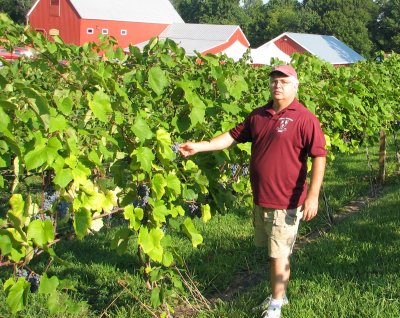
Frank Cleary shows off some of the ripening grapevines on his family's Calvert County winery and vineyard, Friday's Creek Winery. (CNS Photo/Kenneth R. Fletcher)
OWINGS, Md. - Frank Cleary watched last week as a worker clipped red grapes from a vine under the morning sun and dropped them into a white plastic bin.
The rows of grapevines surrounding Cleary would be at home in California, but the humid air and thick green forest nearby placed the vineyard at Friday's Creek Winery in Southern Maryland.
The grape harvest on the Owings farm was five years in the making and something that Cleary, and other grape-growers in the state, hope will become increasingly common.
"Demand is going to grow faster than the grape supply," said Cleary. "We are selling it as fast as we can make it."
The explosive growth in Maryland wineries has led to a demand for Maryland-grown grapes that state farmers have not yet been able to meet, even though state vineyards are producing more every year.
Since 2002, Friday's Creek has added thousands of vines in its 10-acre vineyard. After five years of waiting for the vines to mature, this will be the significant harvest.
But while the winery is now finally able to use its own product, Cleary said Friday's Creek will still be buying frozen grape juice from places like New York and California for years to come.
For every ton of grapes Maryland vineyards sell, local wineries are forced to buy 1.5 tons from out of state, according to Bruce Perrygo, coordinator of the Maryland Grape Grower's Association.
Friday's Creek is part of that wave of new wineries: The number of Maryland wineries has tripled from 10 in 2001 to 30 today, according to the Maryland Wineries Association.
Maryland vineyards have grown as well, from 212 acres of grapes in 2001 to an estimated 513 acres today. But many new vineyards are also wineries and don't sell their grapes, Perrygo said.
"We are in a significant grape deficit," said Ken Korando of Solomons Island Winery. "If the wineries grow in any appreciable size, the likelihood of catching up anytime in the next 10 years is pretty slim."
Maryland is promoting viticulture in the state by providing grants to help grape growers. Since 2005, when the Governor's Advisory Commission on Maryland Wine and Grape Growing was formed, the state has allocated close to $400,000 in funding toward research, promotion and expansion of Maryland wineries and vineyards.
The money goes to funds like the Capital Vine Grant, which so far has provided $65,000 to help 27 grape growers buy vines, said Kevin Atticks of the Maryland Wineries Association.
The funding also supports a viticulture expert and plant pathologist at the University of Maryland who provide free advice to grape growers and research the best types of grapes for the region. The state is even developing a map that will show the best areas for wine growing, based on factors like elevation and soil type.
Starting a vineyard is not cheap and requires specialized skills for planting, pruning and harvest. After an initial large investment for vines, farmers must wait years for the first crop. The labor-intensive harvest is almost always done by hand.
Though many varieties can be grown successfully here, Maryland is not the perfect location for a vineyard. High humidity causes mildew, which requires spraying. Birds and deer damage fruits and vines, despite nets and high fences designed to keep them out.
"We are not California. We can't depend on having a bone-dry summer," said Dick Penna, chair of the wine and grape growing advisory commission.
This summer's drought has actually been a boon for vineyards, concentrating sugars to make ideal wine grapes. In wetter years, rain causes fruit rot during the harvest.
Because of their deep roots, grapes need less water than traditional crops and do not require as much fertilization.
Grapes have other advantages: Once vines are planted they can remain productive for more than 30 years, and because fields do not need to be plowed and planted annually, there is less erosion and runoff.
Grapevines can also grow on slopes and poor soil unsuitable for other crops. The state is promoting it as a good additional crop for farmers who have a few acres that would otherwise go unused, Penna said.
The high demand for Maryland grapes also means high prices. Some varieties can fetch up to $1,500 per ton, with several tons produced per acre under optimal conditions, Penna said.
Rob Plant, owner of Blue Wind Gourmet in St. Mary's County, believes that the demand for local wine will only keep growing.
"There is actually a market for the product . . . These guys are falling short, they want more growers," said Plant. "It's just waiting to explode."
RELATED INFORMATION:
Leonardtown Toasts Launch of New Winery, October 31, 2006
http://somd.com/news/headlines/2006/4712.shtml


